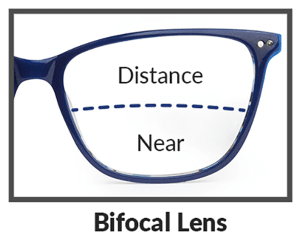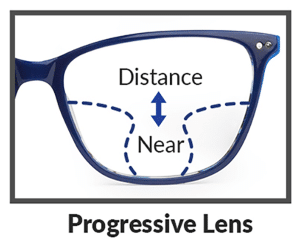
As their name implies, these are corrective spectacle lenses with the same prescription over their whole surface and are available in an extensive range of materials and powers. They are used when you want to have the widest field of view for a specific focus. For example, when driving or reading. They are available in the widest possible range of materials and powers.
Newer materials are now available. If you have a higher prescription, they enable the lens to be much thinner than traditional plastic or glass lens materials. If you would like thinner lenses, come and see us. We are thin lens specialists and we can help you.

Bifocals are used when you need to be able to see two different distances, when wearing the same pair of spectacles. They are usually made with the distance correction in the top or main part of the lens and the near vision correction in the lower part or smaller area, but they can be made with different combinations. The reading segment is placed so that it does not interfere with your vision when you look straight ahead through the distance portion of the lens, but is easily accessible when you look down at something nearer. Bifocals are useful when you require easily defined areas, or need large or unusually placed areas for near vision.

Also known as progressive lenses or multifocals, varifocals make life easier by helping you to see at all distances, without having to strain or change your glasses. You can switch between long, intermediate and close range easily. The top section of the lens gives you clear distance vision and as you look down through the lens, it gradually increases in strength to reading vision at the bottom. Varifocals are perfect for driving and using the satnav for example, when your eyes need to be working on several tasks at different distances, at the same time. They are also much more cosmetically attractive as you can’t see the change between distances. This makes them the lens of choice for the over 40s.
Not all frames are suitable for these lenses. Taking extremely accurate measurements once you have chosen your frame is essential, ensuring perfect vision. Varifocal lenses vary in design, depending on your needs. Some lenses are better for distance and have smaller reading areas. Others are great for computer work and the best give you sharp vision at all distances. The great thing about varifocals is that they can be designed to work best for you. Varifocals sometimes take a few weeks to adjust to, although most people are able to wear them immediately. With our Total Satisfaction Guarantee, you can feel completely confident that your needs will be met.
There are times when ‘standard’ designs are not completely suitable. Some occupations, i.e. pilots, electricians, mechanics and painters and decorators, require the ability see near objects above them, as well as having normally placed distance and reading vision. There are a range of occupational designs for use in these circumstances. If you work with a VDU screen you may benefit from a lens with a much wider intermediate area than normal. Ask us about which occupational lenses for glasses would bests suit you.


These are special lenses for glasses that change tint precisely when needed. Photochromic lenses react quickly to every situation, sunlight or shade, indoors or outdoors. They are virtually clear indoors and can rapidly change to a stylish tint outdoors to give protection against harmful glare. They provide 100% protection from UVA and UVB radiation. They are available in a choice of brown, green or grey tints. Made from lightweight plastic, they are much lighter than glass lenses.
They are really convenient when going in and outdoors to save you having to swap spectacles with sunglasses. However, they do not work as well inside a car due to the car windows absorbing the rays which activate the lenses.



Polarised lenses are used in sunglasses. Unlike ordinary sunglasses lenses, polarised lenses eliminate glare, enhance contrast, improve your vision and offer 100% UV protection.
Polarised lenses have a special inbuilt layer in the lens which filters light. The chemical’s molecules are lined up specifically to block some of the light from passing through the lens.
What you see with polarised lenses is a bit darker than usual, but objects look crisper and clearer, and details are easier to see. They are good for most situations but particularly when you are outside for extended periods of time in the sun. People often say that they are less tired than usual when wearing polarised lenses.
There are a few instances where polarised lenses are not recommended. These are mainly to do with the difficulty seeing images on LCD (liquid crystal display) screens such as:
Not all sunglasses have polarised lenses but the ones that do will usually be labelled as such. You can be certain that all of the Maui Jim sunglasses that we sell are polarised.
These will provide you with many advantages, including better vision, especially at night and more attractive spectacles with almost invisible lenses.
The special coating to both surfaces of your lenses allows light to travel through them more easily. This reduces the amount of glare – a bonus when driving at night or working at a computer screen all day. Because there are fewer reflections people can see your eyes more easily too – important if you work with people.
The latest anti-reflection coatings incorporate special treatments, to resist oils and water, to help keep them cleaner for longer and reduce condensation.
